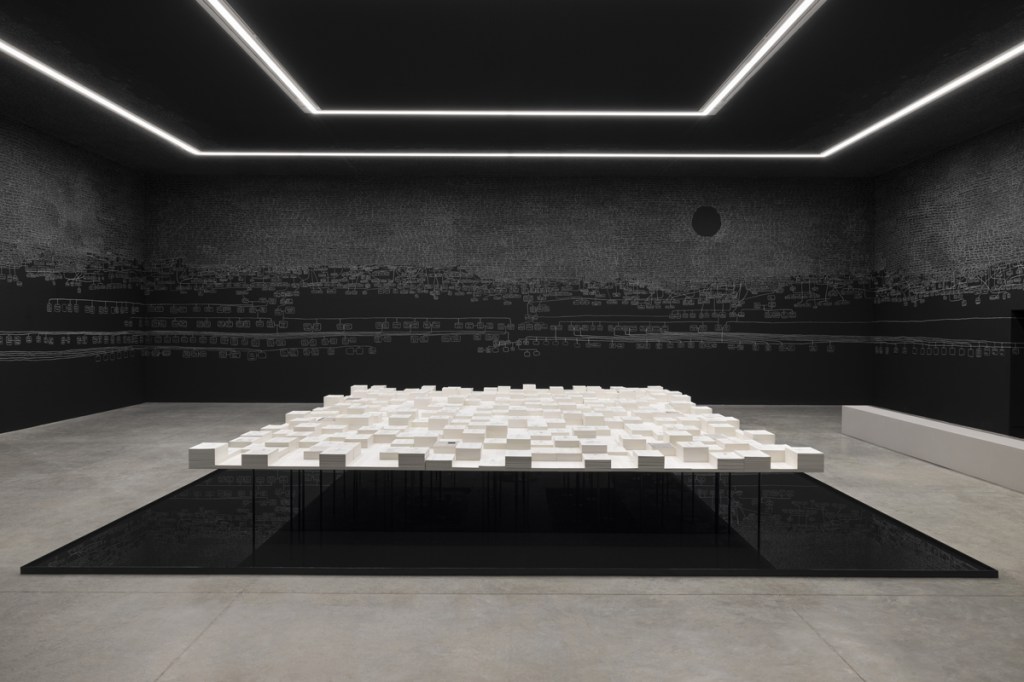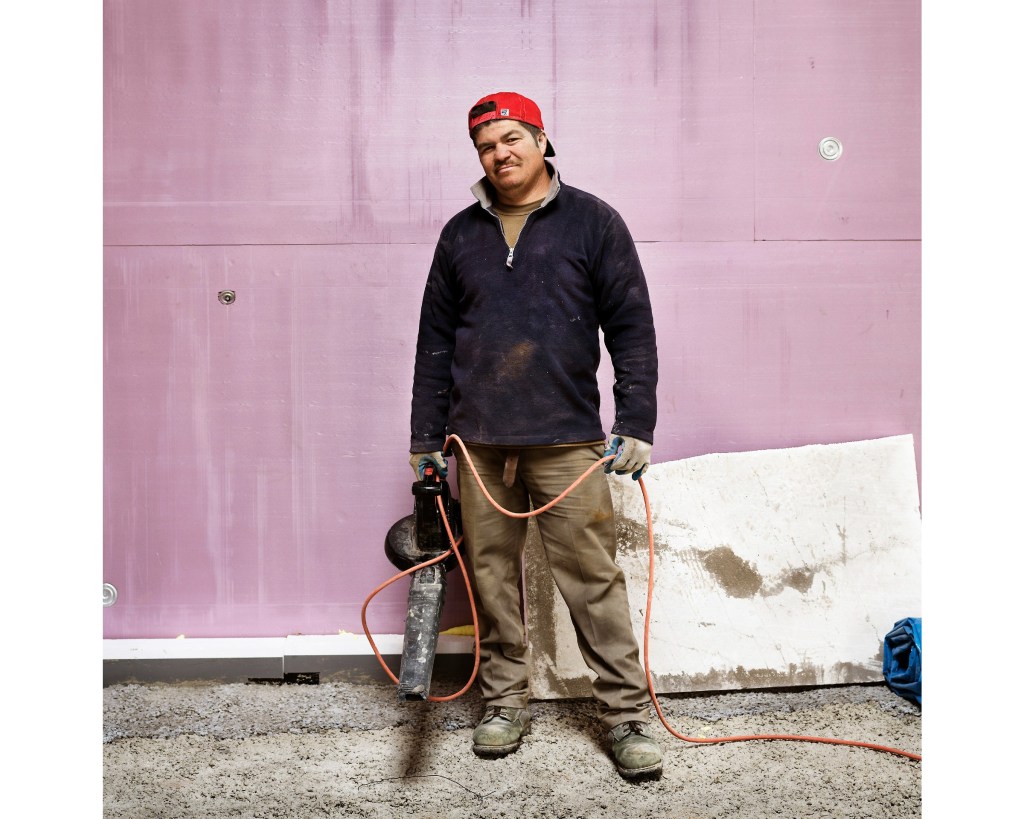With the 2024 Venice Biennale now officially open to the public, the massive Italian art festival announced the winners of its three juried prizes during a press conference this morning.
The exhibition’s top prizes both went to Indigenous artists, with the Golden Lion for the main curated exhibition going to the Mataaho Collective, which consists of four Māori women artists: Bridget Reweti, Erena Baker, Sarah Hudson, and Terri Te Tau. The Golden Lion for the National Pavilion was given to Archie Moore(Kamilaroi/Bigambul), who was Australia’s representative at the Biennale this year.
In the main exhibition, curated by Adriano Pedrosa, the Mataaho Collective, based in Aotearoa (New Zealand), is showing Takapau (2022), a dramatically lit installation made of woven and latticed polyester hi-vis tie-downs. The large-scale work opens the Arsenale section of the Biennale and serves as a passageway to the rest of the show.
“Referring to matrilinear traditions of textiles with its womb-like cradle, the installation is both a cosmology and a shelter. Its impressive scale is a feat of engineering that was only made possibly by the collective strength and creativity of the group,” the jury said in their citation for the prize, which was read by the jury president Julia Bryan-Wilson.
Queensland-based Moore has this year transformed the Australia Pavilion in the Giardini with two installations. He painted the walls of the pavilion chalkboard black and spent several months hand-writing, via chalk, the names of his family tree, going back 65,000 generations. In the center of the pavilion, he created a reflecting pool, over which floats a rectangular plinth. Atop this base are hundreds of redacted documents reporting deaths of First Nations people while in police custody. (ARTnews had predicted Moore to be a winner for the pavilion.)
“Thus 65,000 years of history (both recorded and lost) are inscribed on the dark walls as well as on the ceiling, asking viewers to fill in blanks and take in the inherent fragility of this mournful archive,” the jury said in its citation.
The third juried prize, the Silver Lion for a Promising Young Participant in the International Exhibition, was awarded to Karimah Ashadu, who was born in London and raised in Nigeria, and is now based in Hamburg and Lagos. In the Biennale, she is showing the video Machine Boys (2024), which focuses on motorcycle taxis, called okada, that were recently banned in Lagos.
“Her feminist camera lens is extraordinarily sensitive and intimate, capturing the bikers’ subcultural experience as well as their economic precarity,” the jury said.
This year’s jury was chaired by Julia Bryan-Wilson, an American curator who is art history professor at Columbia University, who selected the winners alongside four other international curators. They are Alia Swastika, an Indonesian curator and writer who is the director of Biennale Jogja Foundation in Yogyakarta, Indonesia; Chika Okeke-Agulu, a Nigerian curator and art critic who is a professor of art history and African American studies at Princeton University; Elena Crippa, an Italian curator who is the head of exhibitions at the Whitechapel Gallery in London; and María Inés Rodríguez, a French Colombian curator who is director of the Walter Leblanc Foundation in Brussels and artistic director of Tropical Papers.
Additionally, the jury awarded special mentions to Samia Halaby and La Chola Poblete for their participation in the main exhibition, as well as one to the Republic of Kosovo for a sculptural installation by Doruntina Kastrati.
Halaby is a Palestinian artist based in New York who has one abstract painting, Black Is Beautiful (1969), on view in the exhibition’s “Nucleo Storico.” Okeke-Agulu, reading the jury’s citation, said, “Her commitment to the politics of abstraction has been married to her unwavering attention to the suffering of the people of Palestine. Her gorgeously rendered modernist painting … suggests not only the sovereignty of the imagination but also the importance of global solidarities.”
Halaby, who had returned to New York ahead of the press conference and spoke via video conference, dedicated her award to the “youthful members of the press in Gaza who murdered for giving a great gift of documentation to human culture that is meaningful to all the Indigenous people of the world who stateless.”
In its citation, the jury said La Chola Poblete, who is showing a suite of watercolors, “engages in critical play with histories of colonial representation from a trans Indigenous perspective. Her multivalent art … resists the exoticization of Indigenous women while she insists on the power of sexuality.”
Representing Kosovo, Kastrati is showing sculptures that reference the factory production of Turkish delights. In its citation, the jury called the pavilion “a vibrating soundscape travels up through the floor, resonating both in our bones and echoing a larger arena of feminist activism.”
Anna Maria Maiolino and Nil Yalter, the previously announced recipients of the Golden Lion for Lifetime Achievement, came to the stage to receive their awards. (Pedrosa took a selfie with both winners after.)
After receiving the award, Maiolino, who was born in Italy and is now based in Brazil, dedicated her win to “Brazilian art, to the country that has hosted me for so many years.” In a brief remark, Pedrosa called her “a reference for many generations of artists in Brazil, and beyond.”
Yalter, whom Pedrosa heralded for “her extraordinary contributions to the visual arts, especially her research and work around immigration,” said she wanted to dedicate “this flying lion,” referring to the physical prize’s shape, to “peace in the world that’s all we need. At this moment, we need peace in the world. Absolutely.”
At the end of the press conference, Italian culture minister Gennaro Sangiuliano began by citing Pedrosa’s New York Times interview ahead of the Biennale, in which Pedrosa said he “had complete freedom and autonomy to develop the project.”
Sangiuliano assured the public that “it always be like this.”


